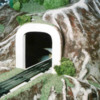The felt was a custom product produced by a now defunct manufacturer. There is nothing available today that will match the exact felt used by Lionel, which was a wool based felt product. Kunin Felt used to make a acrylic felt in their "Rainbow Classic" line called "Greystone" that was pretty close, but it was lighter in both color and weight than the Lionel stuff. Acrylic felt does not work as well, since it doesn't shrink when it dries like the wool felt. The shrinking helps with getting all of the "nooks and crannies" that was the signature of these felt mountains. Sutherland Felt makes ASTM grade gray pressed wool felt, but the thinnest thickness is something like 1/16", which is way too thick. I have no further suggestions for you on locating the felt. You would need at least two 920 sets worth of felt to make the mountain on a D-148, which is the same size and shape as the mountain on my D-165 layout, but mine was made in one piece. After building a frame of different lengths of 1"X 1" vertical supports and cutting out the tunnel portals from either 1/2" pine or plywood (Lionel didn't use the molded 920 portals until 1958), wire screen was crumpled and then draped over the supports (this is consistent with the way Lionel did it up to and including 1954. After that, they used brown kraft paper instead). A scrap piece of cloth (like an old bed sheet or similar) was then draped over the screen and tacked in place, cut as necessary around the portals and the edges. This was used as a pattern to cut out the felt. Once the felt was cut out, it was dipped into a solution of "fish glue", which can be purchased at organ supply companies like "Organ Supply Industries", "Arndt Industries" etc. It is mixed with hot water and used heated. It is very sticky and has a "unique" smell. But it is important to use this type of glue. The reason is that the glue (which today is used to fasten leather bellows material to wood backings in organ mechanisms) crystallizes when it dries, so the resulting shell will become rock hard. Another option if you do not have a large hot-pot is to use stabilized animal hide glue, which can be used cold. It too has a rather unpleasant smell, and the resulting wool mountain will smell like a old wet dog! Once the glue soaked felt is draped over the screen and tugged and pinched in place, use crumpled up newspaper here and there between the screen and the felt to build up humps and bumps as you like. The felt will dry overnight to a surprisingly rock hard surface that is quite durable. But keep this in mind - the glue is hygroscopic, meaning it will always take moisture from the air or elsewhere and may never fully "set". This isn't a bad thing, as it will allow you to repair the mountain years from now in case it sags by re-wetting it with a spray bottle (this is one method used by restorers of original dealer displays). If you live in a very humid climate, this may not be the best way to build a mountain if you don't have air conditioning available! The paints I used were the same as what Lionel used - casein theater paint mixed with the hot fish glue. The paints can be purchased from Rosebrand as scenic paints. The reason to mix it with the fish glue is that these paints don't have a binder and their colors will fade rather quickly if not mixed with the glue. The usual burnt and raw umber as well as sienna brown or red is used. The "rocky outcroppings" are picked out in the same tan paint that is used for the roads and track beds. The best suggestion I have is to study a real Lionel display layout so that you can see exactly how the mountains were painted. No art skills are required, after all, the real ones were painted assembly line fashion by college students working in the summer. After everything dries, the same green paint is used for grassy areas, and the 919 grass sprinkled on. If you are using latex paint, be sure to use an extender to have enough "open" time for the grass to stick. The grass patches should not be put on willy-nilly, but should be placed on the flatter areas, where grass would grow in real life. The usual lichen is used for trees and shrubs, and it is important to select good specimens that are plump and have good shape. Out of a full bag of lichen from Woodland Scenics, I usually get only about 20% good clumps. Mix the colors of dark, medium, light and spring green into nice clumps and attach them in a way that is more "vertical" than "horizontal". That is is the way to get the original "Lionel" look. Hope the forgoing helps. Keep up the good work!
OGR Forum Supporting Membership Required
Access to this requires an OGR Forum Supporting Membership
OGR Forum Supporting Membership

Help support this forum with an OGR Forum Supporting Membership.
You will be able to watch the videos in the INSTRUCTIONAL VIDEO FORUM!
A one-year OGR Forum Supporting Membership is only $12 per year, so sign up now!
OR
Access the ALL the OGR VIDEO FORUMS AND over 300 back issues of OGR
with a DIGITAL SUBSCRIPTION!
$12.00 per 12 Months (plus tax if applicable)




